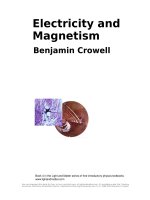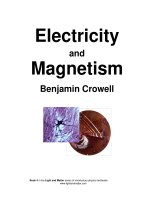Electricity and magnetism 2
Bạn đang xem bản rút gọn của tài liệu. Xem và tải ngay bản đầy đủ của tài liệu tại đây (9.67 MB, 31 trang )
Electricity
and
Magnetism
Lessons 4–7
Copyright © by Harcourt, Inc.
All rights reserved. No part of this publication may be reproduced or transmitted in
any form or by any means, electronic or mechanical, including photocopy, recording,
or any information storage and retrieval system, without permission in writing from the
publisher.
Requests for permission to make copies of any part of the work should be addressed to
School Permissions and Copyrights, Harcourt, Inc., 6277 Sea Harbor Drive, Orlando,
Florida 32887-6777. Fax: 407-345-2418.
HARCOURT and the Harcourt Logo are trademarks of Harcourt, Inc., registered in the
United States of America and/or other jurisdictions.
Printed in the United States of America
ISBN-13: 978-0-15-349174-0
ISBN-13:
ISBN-10: 978-0-15-349174-0
0-15-349174-4
ISBN-10: 0-15-349174-4
1 2 3 4 5 6 7 8 9 10 179
15 14 13 12 11 10 09 08 07 06
1 2 3 4 5 6 7 8 9 10
15 14 13 12 11 10 09 08 07 06
179
If you have received these materials as examination copies free of charge, Harcourt
School Publishers retains title to the materials and they may not be resold. Resale of
If you have received these materials as examination copies free of charge, Harcourt
examination copies is strictly prohibited and is illegal.
School Publishers retains title to the materials and they may not be resold. Resale of
examination copies is strictly prohibited and is illegal.
Possession of this publication in print format does not entitle users to convert this
publication, or any portion of it, into electronic format.
Possession of this publication in print format does not entitle users to convert this
publication, or any portion of it, into electronic format.
Electricity
and
Magnetism
Lessons 4–7
Lesson 4
How Can You Detect a Magnetic Field?. . . . . . . . .2
Lesson 5
What Makes an Electromagnet?. . . . . . . . . . . . . . .8
Lesson 6
How Are Electromagnets Used?. . . . . . . . . . . . . .14
Lesson 7
How Is Electrical Energy Used?. . . . . . . . . . . . . . 24
Visit The Learning Site!
www.harcourtschool.com
VOCABULARY
�
VOCABULARY
compass
2
How Can
You Detect
a Magnetic
Field?
A compass helps you find directions. It
tells you which way is north.
3
READING FOCUS SKILL
CAUSE AND EFFECT
A cause is something that makes another thing
happen. An effect is the thing that happens.
Look for what causes a compass to point north.
Look for the effect a magnet has on another
magnet.
Finding the North Pole
Earth has a North pole and a South pole. You might
think of them as the “top” and “bottom” points of
Earth. They are the imaginary points that do not move
as Earth rotates. Earth’s core is a huge magnet. Because
of this, Earth also has magnetic poles. It has a giant
magnetic field.
This bar magnet can
swing freely. It lines
up along Earth’s
magnetic field lines.
4
A magnetic field fills the space
around Earth. The compass
needles are lining up with
Earth’s field lines.
A magnetic field fills the space around Earth. You saw
the way iron filings lined up around a magnet. They
showed that the magnetic field was strongest at the
magnet’s poles. This is also true of Earth’s poles. A magnet
hanging near one of Earth’s poles would line up with the
field. It would point into the ground.
What causes a compass needle to move?
5
Compasses
A compass is a tool used to find direction. Compasses
help sailors and others find their way in bad weather. The
needle in the compass is magnetic. It turns freely on top
of a point. The needle lines up with Earth's magnetic field.
To use a compass, hold it level and turn your body until
the needle points at the N. You are now facing north.
The face of the compass shows the four main directions—
north, south, east, and west. East is to your right. West is
to your left. South is behind you.
What might be the effect of having a compass
with you if you were lost in the woods?
Case: The case
protects the
floating needle
from damage.
Markings: Labels
and degree lines
help the user find
an exact direction.
6
Pivot: The needle
is balanced on a
point. So it can
turn freely.
Liquid: The liquid
keeps the needle
from bouncing and
jerking.
Magnetic Interference
Magnets or large metal objects interfere with a
compass. If they are nearby, the compass may not work
correctly. The best place to use a compass is outdoors.
Stay away from other magnets, buildings, power lines,
and cars, and your compass will work correctly.
How can magnets cause problems with the way
a compass works?
The compass is not
pointing to Earth’s
magnetic north. It
is pointing to the
magnet instead. C
Review
Fill in the blank to answer the following cause and
effect statements.
1. Earth’s core acts like a giant ______ .
2. A compass needle turns to line up along
______ magnetic field lines.
3. If you are lost, a ______ is a tool that can help
you find your way.
4. Other a ______ or a ______ can interfere with
the way a compass works.
7
VOCABULARY
�
VOCABULARY
electromagnet
8
What
Makes an
Electromagnet?
You can make an electromagnet with a
nail, some covered wire, and a battery.
The wire will carry current. The nail will
become a magnet.
9
READING FOCUS SKILL
MAIN IDEA AND DETAILS
The main idea is what the text is mostly about.
Details are pieces of information about the main idea.
Read about what an electromagnet is.
Look for details about how you would control an
electromagnet.
Making a Magnetic Field
You know that electric charges can push or pull.
Magnets also have a force that can push or pull. Are
magnetism and electricity related?
Nothing happens when you put iron filings near a
copper wire. Now run a current through the wire. A weak
magnetic field forms. The picture shows a wire coil that
carries a current. Notice what the iron fillings show. It is
the shape of the magnetic field inside the coil.
The lines of the filings are
closest together where the
field is strongest.
10
Electric current from the battery runs through the
wire around the iron nail. The current makes the nail
magnetic. Taking out the battery stops the current.
The iron filings would no longer stick to the nail.
The magnetic field around a current-carrying wire can
move a compass needle. You can make the field stronger.
You can wrap the wire around an core, such as a nail.
You can make an electromagnet. Wrap a coil of wire
around an iron nail. Attach a battery to the wire. The nail
becomes a magnet when electric current flows in the
wire. The nail is a magnet only when current is flowing.
How can electricity be used to make a magnet?
11
Controlling Electromagnets
An electromagnet is a temporary magnet. You can turn
it on and off. How could a magnet like this be useful? A
powerful electromagnet can pick up tons of iron scrap.
A worker could turn on the electromagnet to pick up the
iron. The worker simply turns off the electromagnet to
drop the iron.
The strength of an
electromagnet depends
on the number of coils.
12
There are two ways to make an electromagnet stronger.
One is by adding more coils. The other is increasing
the electric current. For example, you could add more
batteries.
We use electromagnets in many ways. They are found
everywhere. Some are inside your telephone. Some are
outside at the automobile junkyard!
How can you control electromagnets?
This electromagnet is
stronger because it uses
two batteries.
Review
Fill in this main idea statement.
1. An ______ is a magnet that has coils of currentcarrying wire around an iron core.
Fill in these detail statements about electromagnets.
2. An electromagnet is a ______ magnet. It can be
turned on and off.
3. Magnets produce a force that can push or
______ , just as electric charges can.
4. The strength of an electromagnet depends on
the number of its ______ .
13
�
VOCABULARY
VOCABULARY
kinetic energy
electric motor
generator
How Are
Electromagnets
Used?
This wind farm is changing
kinetic energy, or energy
of motion, to electricity.
14
A small toy car has a small electric
motor. The motor makes it move.
People use portable generators when
their power goes out.
15
READING FOCUS SKILL
COMPARE AND CONTRAST
You compare things by looking for ways they are
similar. You contrast things by looking for ways they
are different.
Look for devices that use electromagnets. Look for
ways they are alike and different.
Electromagnetism and Motion
You can create a device that changes battery electricity
into motion. Take a plastic drinking straw and wrap many
coils of wire around it. Leave the ends of the wire free.
Lay the straw on the table, and slide an iron nail partway
inside. Now attach the ends of the wire to a battery.
The nail will move! The magnetic field inside the coil
produces a force. The force moves the nail.
This device changes energy from the battery to motion.
Energy of motion is called kinetic energy.
wire coil
spring
iron core
16
The switch turns
the current on
and off.
The device in the picture works the same way the nail
in the straw did. Turning the current on and off produces
motion, or kinetic energy.
Changing electricity to kinetic energy is useful. One way
is in starting a car. The driver turns the key. This closes a
switch. A tiny current to travels through a relay. The relay
closes a switch in a different circuit. The relay moves a rod
to touch another piece of metal . Now electricity can flow
and start the car.
What is kinetic energy?
17
Doorbells and Speakers
A doorbell is another example of an electromagnet.
Pushing the button turns the current on. When the
current is on, a rod moves into the coil. The rod strikes
a bell. Ding! When you release the button, the current
goes off. A spring pushes the rod quickly out of the coil.
Dong! The rod strikes a different bell.
This type of doorbell has a clapper instead of chimes and a rod.
When the doorbell button is pushed, current flows through the
wire. As the current switches direction, the electromagnet first
attracts the clapper. Then it repels. The bell rings. The clapper
vibrates back and forth. The bell rings.
doorbell button
clapper
bell
electromagnet
18
Speakers and headphones also use electromagnets.
Microphones change sounds into electrical signals. When
the signals reach a speaker, they are turned back into
sounds.
Every speaker has a flexible diaphragm. The diaphragm
is attached to a magnet. A wire coil wraps around the
magnet. Electric signals pass through the coil. This causes
the coil to push and pull on the magnet. The diaphragm
vibrates, causing sound waves. You hear the music!
How is the electromagnet in a doorbell different
from the ones in speakers?
diaphragm (part that vibrates)
magnet
voice coil
19
Electric Motors
Have you ever cooled off with an electric fan? A fan
contains a small motor. An electric motor changes
electrical energy into kinetic energy. Motors usually cause
things to rotate, or spin.
A simple motor has a wire coil and a permanent
magnet. Current flows through the wire. The magnet
pulls on the coil. The coil turns halfway. The current
switches direction. Now the magnet pushes on the coil.
The coil turns halfway again. This pattern repeats again
and again. The motor spins.
Compare the way an electric motor works with
a magnet’s push and pull.
The electric motor inside a
fan has a coil of wire and a
permanent magnet.
20
Generators
A generator converts other forms of energy into
electrical energy. In an emergency, electricity can go out.
People can get electricity by running a generator with
gasoline. It can provide electricty for lights. It can provide
electricity for keeping food cold.
Energy plants have huge generators that contain
electromagnets. The energy plants burn fuel. The fuel
heats water to change it to steam. The steam pushes
against fan blades, which turn a shaft. The shaft turns
electromagnets inside heavy coils of copper wire. The
spinning magnets cause current in the wire.
How are the ways generators and speakers
work alike?
Review
Fill in the blank to answer the following compare
and contrast statements.
1. Energy of motion is called ______ ______ .
2. Electrical energy can be changed into kinetic
energy with an ______ ______ .
3. A ______ is a machine that converts other
forms of energy into electrical energy.
4. Speakers, headphones, and doorbells use
______ .
21
VOCABULARY
7
VOCABULARY
insulate
22
How Is
Electrical
Energy
Used?
A wire is insulated to protect you from
electric current.
23







